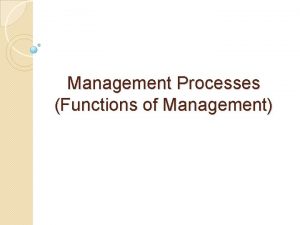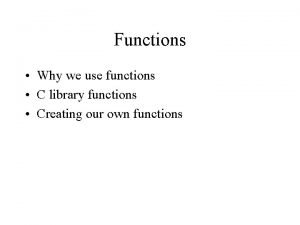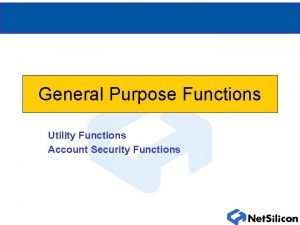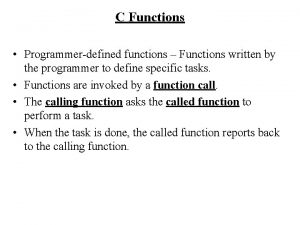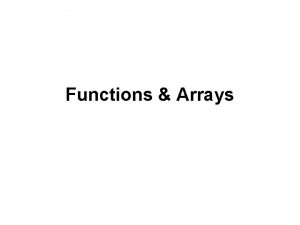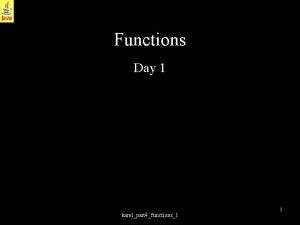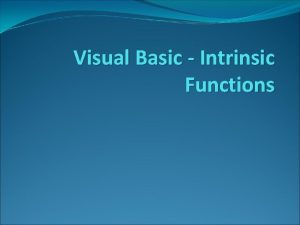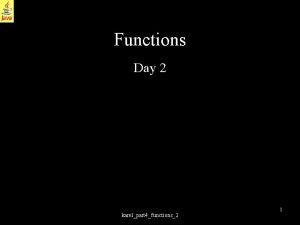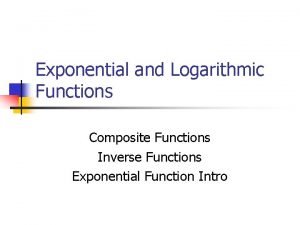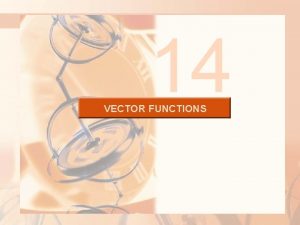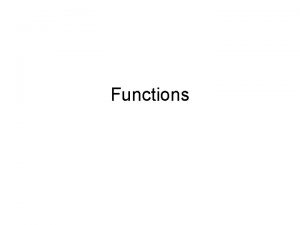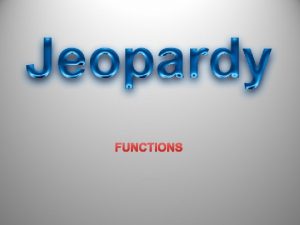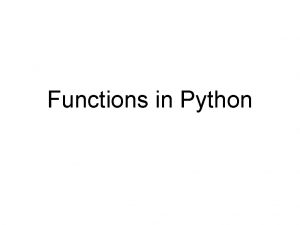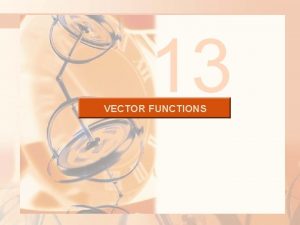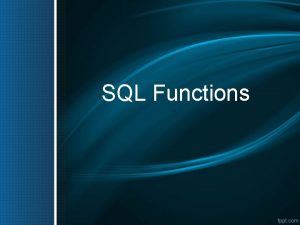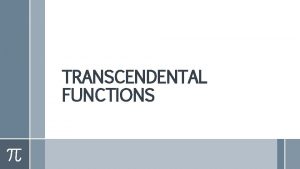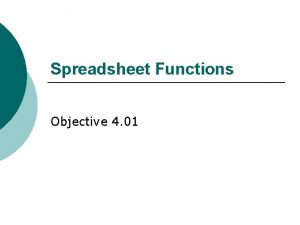FUNCTIONS OF MANAGEMENT MANAGEMENT DEFINITION Management is the






































- Slides: 38

FUNCTIONS OF MANAGEMENT

MANAGEMENT DEFINITION: Management is the administration of an organization, whether it be a business, a not-for-profit organization. Management may be defined as art and science of getting the work done through people with satisfaction for employer, employee and the public.

IMPORTANCE OF MANAGEMENT �Creates dynamic and life giving force to the enterprise �Coordinate activities of different department �Establishing team spirit among the persons �Meets the challenges of changes �Tackles the business problems and provides tools for doing things in a better way �Provides new ideas and vision to the organization

LEVELS OF MANAGEMENT � 1. Top level Management-Board of directors, Managing Directors, owners etc. . � These are responsible for designing goals and policies of the organisation � Sets objectives to Senior level management � Looks for expanding, monitoring performance, financial responsibilities, designing/ redesigning of organisation � 2. Senior Level Management-Includes managers of different departments namely, Sales, Production, Finanace, Accounts, Research and Development etc. . � They formulate the objective, duties of Middle level Management � Responsible for establishing different departments, designing of operation policies and routine activities.

LEVELS OF MANAGEMENT � 3. MIDDLE LEVEL MANAGEMENT- It includes Superintendents, branch Managers, etc. . � Coordinating between different parts of organisation � Buliding efficient Company team Spirit � Conducting training for employee development � 4. LOWER LEVEL MANAGEMENT- It includes Supervisors, Chargemens, etc. . � Supervising the workers and their work � Improving work methods and operations � Instructions to the workers

DIIFRENT TYPES OF SKILLS �MANAGERIAL SKILLS �TECHNICAL SKILLS �CONCEPTUAL SKILLS �A) Decision Making Skills �B) Organisation Skills �HUMAN RELATION SKILLS �A) Communication Skills �B) Motivational Skills �LEADERSHIP SKILLS

CLASSIFICATION OF MANAGEMENT FUNCTIONS • Managerial Functions • MANAGEMENT FUNCTIONS • Operative Functions

CLASSIFICATION OF MANAGEMENT FUNCTIONS Managerial functions a)Planning b)Organising c)Staffing d)Directing e)Controlling f)Coordinating �MANAGEMENT FUNCTIONS Operational functions a)Production b)Marketing c)Purchasing d)Financing e)Personnel

• According to Luther Gullick gave the keyword �P……………Planning �O……………. . . Organising �D……………. . . Directing �S……………Staffing �CO……………. Coordinating �R……………Reporting �B……………Budgeting

MANAGEMENT PROCESS

MANAGERIAL FUNCTIONS � PLANNING: Forecasting Future Circumstances and requirements, Making long term plans, decision making, strategy, formulation policy-Making, programming, scheduling, budgeting problem solving, innovation, investigation and Research. � ORGANISING: Is a Process by which strcture and allocation of jobs are determined and Responsiblities are assigned, Functionalization, divisionalisation, departments, Decentralisation, activity, analysis, task, span of management, task allocation. � STAFFING: Man power planning, Recruitment, selection, training, placement, compensation, promotion. � DIRECTING: Supervision, motivation, communication, leadership. � COORDINATING: Process of Achieving department and individual efforts towards reach the company's objective. • CONTROLLING Measurement of Performances, Fixation of standards, recording, measurement reporting, corrective action.

PLANNING �Planning is deciding in advance what is to be done in future. �“According to Koontz and O ‘Donnell defines Planning means Deciding in advance : �What to do �How to do �When to do �Who is going to do it � Bridges a gap between where we are today and where we want to reach. �Sets the goal of an organization.

PLANNING �It is the basic function of management. It deals with chalking out a future course of action & deciding in advance the most appropriate course of actions for achievement of pre-determined goals. �It is an exercise in problem solving & decision making. Planning is determination of courses of action to achieve desired goals. �Thus, planning is a systematic thinking about ways & means for accomplishment of pre-determined goals. Planning is necessary to ensure proper utilization of human & non-human resources. It is all pervasive, it is an intellectual activity and it also helps in avoiding confusion, uncertainties

Features of planning �Planning seeks to achieve certain objectives. �Planning is oriented towards the future. �Planning is a mental exercise. �Planning involves choices from alternatives. �Planning is the basics for all other functions. �It is a continuous function. �It is pervading. �Planning is directed towards efficiency.

Steps in planning �Collecting information about past. �Defining objectives. �Developing planning premises. �Discovering alternative courses of action. �Evaluating alternatives. �Choosing the best alternatives. �Defining subsidiary plans. �Periodic revision and review of plans.

Advantages of planning �It focuses attention on desired objectives. �It helps to minimize risk. �It improve efficiency. �It avoid confusions. �It encourage innovation and creativity. �It enables co operation and group work. �It serves as the basis of control.

Planning is Classified in different ways �CORPORATE PLANNING-Planning at top level, which covers all the activities of the organisation. �FUNCTIONAL PLANNING-Planning of Functions namely production/operations/ marketing, finance, human resource etc. . �STRATEGIC PLANNING-Planning involves deciding major goals and policies of organisation. �Examples�Planning growth rates in sales, diversification of business into new areas etc. . �TRACTICAL PLANNING-Planning involves deciding how resources will be used to the advantage of the organisation in acivement of strategic goals. It is also called as operational Planning/ Short term Planning.

PROCEES OF PLANNING Perception of Opportunities Planning Premises Establishing Objectives Planning Premises Identification of Alternatives Evaluation of alternatives Choice of Alternative Plans Formulation of Supporting Plans Establishing sequence of Alternatives

Limitations of planning �Lack of accurate information �Time consuming �Expensive �Rigidity due to strict compliance with plans �Unwillingness to people change �External limitations (political )

How we overcome the limitations? �Top management support �Better forecasting �Developing clear-cut objectives �Participation of employees in planning �Sound communication �Overcoming resistance to change �Scientific planning �Well balanced keeping plans.

Organizing It is the process of bringing together physical, financial and human resources and developing productive relationship amongst them for achievement of organizational goals. According to Henri fayol “To organize a business means to provide it with everything useful to its functioning-raw materials, tools, capital and personnel. ”

�Establishing the framework of working: �How many units or sub-units or departments are needed. �How many posts or designations are needed in each department. �How to distribute authority and responsibility among employees �Once these decisions are taken, organizational structure gets set up.

Steps in organizing �Identifying the activities required for achieving objectives. �Classifying these activities in to convenient groups �Assigning the group of activities to appropriate persons. �Delegating authority and fixing responsibilities. �Coordinating Authority Responsibility relationship throughout the enterprise.

Importance of organizing �Sound organization facilitate growth and diversification �Optimum use of human resources by matching work with talent �Maintain good harmonious structure in the office �Group activity is equivalent to social structure of organization �It is a mechanism of management to direct , controls and coordinates the activities of enterprise.

Staffing �It is concerned with the Human resources of the enterprise. �It is concerned with acquiring, developing, utilizing and maintaining human resources. �It is a process of matching jobs with individuals to ensure right man for the right job.

Staffing �Recruiting, selecting, appointing the employees, assigning duties, maintaining cordial relationship and taking care of grievances of employees. �Training and Development of employees, deciding their remuneration, promotion and increments. �Evaluting their performance.

Definition of staffing �According to Koontz and O Donnel “The managerial functions of staffing involves manning the organizational structure through proper and effective selection, appraisal and development of personnel to fill the roles designed in to the structure.

Steps in staffing �Manpower planning �Recruitment, selection, placement �Training and development �Appraisal , promotion and transfer �Employee remuneration

Features of staffing �It is a function of management �It is an integral part of the process of management. �It is concerned with the human resources �It is a pervasive function �Aims at optimum utilization of human resources.

Importance of staffing �It helps in discovering and obtaining competent employees for various job. �It improve the quantity and quality of output by putting right man for right job. �It improves job satisfaction of employees �It reduces cost of personnel by avoiding wastage of human resource. �It facilitates the growth and diversification.

Directing �It is concerned with the execution of plans through organized action. �It is also known as commanding or actuating.

Directing �Giving direction or instruction to employees to get the job done. �Leadership qualities are required. �Motivating employees by providing monatory and non-monetory incentives. �Comunicating with them at regular intervals.

Directing �Supervision- implies overseeing the work of subordinates by their superiors. It is the act of watching & directing work & workers. �Motivation- means inspiring, stimulating or encouraging the sub-ordinates with zeal to work. Positive, negative, monetary, non-monetary incentives may be used for this purpose. �Leadership- may be defined as a process by which manager guides and influences the work of subordinates in desired direction. �Communications- is the process of passing information, experience, opinion etc from one person to another. It is a bridge of understanding

Controlling �Matching actual performance with the planed goal. �If problem, tries to find out the reasons of deviation. �Suggesting corrective measures come on the path of plan

CONTROLLING: �It implies measurement of accomplishment against the standards and correction of deviation if any to ensure achievement of organizational goals. The purpose of controlling is to ensure that everything occurs in conformities with the standards. An efficient system of control helps to predict deviations before they actually occur. According to Theo Haimann, “Controlling is the process of checking whether or not proper progress is being made towards the objectives and goals and acting if necessary, to correct any deviation”.

�Therefore controlling has following steps: �Establishment of standard performance. �Measurement of actual performance. �Comparison of actual performance with the standards and finding out deviation if any. �Corrective action.

OPERATIONAL FUNCTIONS A)PRODUCTION B)MARKETING C)PURCHASING D)FINANCING E)PERSONNEL

 Hình ảnh bộ gõ cơ thể búng tay
Hình ảnh bộ gõ cơ thể búng tay Frameset trong html5
Frameset trong html5 Bổ thể
Bổ thể Tỉ lệ cơ thể trẻ em
Tỉ lệ cơ thể trẻ em Chó sói
Chó sói Chụp tư thế worms-breton
Chụp tư thế worms-breton Hát lên người ơi alleluia
Hát lên người ơi alleluia Môn thể thao bắt đầu bằng chữ f
Môn thể thao bắt đầu bằng chữ f Thế nào là hệ số cao nhất
Thế nào là hệ số cao nhất Các châu lục và đại dương trên thế giới
Các châu lục và đại dương trên thế giới Công thức tính độ biến thiên đông lượng
Công thức tính độ biến thiên đông lượng Trời xanh đây là của chúng ta thể thơ
Trời xanh đây là của chúng ta thể thơ Mật thư tọa độ 5x5
Mật thư tọa độ 5x5 101012 bằng
101012 bằng Phản ứng thế ankan
Phản ứng thế ankan Các châu lục và đại dương trên thế giới
Các châu lục và đại dương trên thế giới Thể thơ truyền thống
Thể thơ truyền thống Quá trình desamine hóa có thể tạo ra
Quá trình desamine hóa có thể tạo ra Một số thể thơ truyền thống
Một số thể thơ truyền thống Cái miệng xinh xinh thế chỉ nói điều hay thôi
Cái miệng xinh xinh thế chỉ nói điều hay thôi Vẽ hình chiếu vuông góc của vật thể sau
Vẽ hình chiếu vuông góc của vật thể sau Thế nào là sự mỏi cơ
Thế nào là sự mỏi cơ đặc điểm cơ thể của người tối cổ
đặc điểm cơ thể của người tối cổ Thứ tự các dấu thăng giáng ở hóa biểu
Thứ tự các dấu thăng giáng ở hóa biểu Vẽ hình chiếu đứng bằng cạnh của vật thể
Vẽ hình chiếu đứng bằng cạnh của vật thể Phối cảnh
Phối cảnh Thẻ vin
Thẻ vin đại từ thay thế
đại từ thay thế điện thế nghỉ
điện thế nghỉ Tư thế ngồi viết
Tư thế ngồi viết Diễn thế sinh thái là
Diễn thế sinh thái là Dạng đột biến một nhiễm là
Dạng đột biến một nhiễm là Bảng số nguyên tố
Bảng số nguyên tố Tư thế ngồi viết
Tư thế ngồi viết Lời thề hippocrates
Lời thề hippocrates Thiếu nhi thế giới liên hoan
Thiếu nhi thế giới liên hoan ưu thế lai là gì
ưu thế lai là gì Khi nào hổ mẹ dạy hổ con săn mồi
Khi nào hổ mẹ dạy hổ con săn mồi Khi nào hổ con có thể sống độc lập
Khi nào hổ con có thể sống độc lập










































